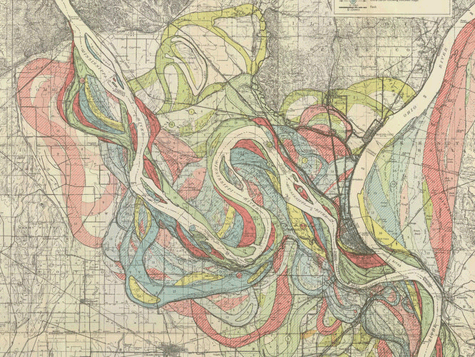
- Wednesday, September 22nd, 2010
- old paths and new paths
-
In 1944, the cartographer Harold Fisk released his spectacular drawings that showed the paths that had been taken by the Mississippi River over time. (Shown is just the section that contains the confluence with the Ohio River; the entire work is masterful.NPR | See the whole thing in this piece by Robert Krulwich.)

Like the Mississippi, the market for investments is hard to understand. It is massive and unwieldy. Just when we think that we have it figured out or think that we have mastered it with engineering feats, it migrates and creates anew.
Fisk detailed the history of the river and in the process showed not just that change occurs, but what the old paths looked like. In the same way, studying market history grounds you in the lessons of the past. Mark Twain, who knew the river, is supposed to have said that history doesn’t repeat itself, but that it does rhyme.There are many derivations of this saying published here and there and I’ve never seen a concrete citation, so if you have one please send it to me.
The map was a cartographic feat, but it was surely inexact. So too with the market. We are forced to infer what has happened, but we don’t always have enough knowledge to be precise in our drawings. Nevertheless, like the rare technicians who still do charts by hand, we can benefit from the process.
But that is what was, and we know that things are going to change. As with the river, it can happen in a flash or it can take eons. We must speculate how and why and when the changes will occur if we are to position ourselves on the market river to avoid calamities. Yet it is so common to make the assumption that staying in the previous navigation lanes makes sense, when at any minute the erosion on the bank over there could cause it to collapse, or the fault line that lies underneath the river could lead to an earthquake that changes the channel in incredible ways.
Pondering the Fisk drawings leads to questions about methodology too. Not only has the market changed, but our approach has changed. Looking back on your old paths and those of your firm: Why did they exist? Why did they change? Would staying on the old path of decision making have actually been better than taking the new one that you did?
And, going forward, where might your new paths be? Looking at the topography of the market now, how might it change in the future and what should you be doing to anticipate those changes and/or be ready to adapt to them when they arrive?
To prepare ourselves, we must look backward for perspective and forward toward the possibilities. The waters are ever in flux, and if we are to captain the boat, we must always remember what we have learned from our journeys along the river, while being on the lookout to navigate into new waters when the situation demands it.
